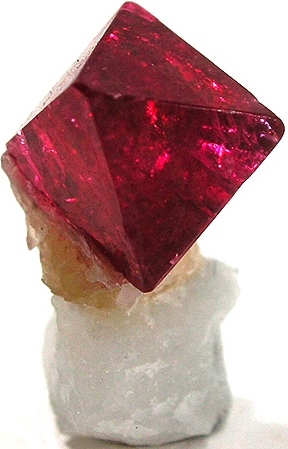
Spinel is the magnesium/aluminium member of the larger spinel group of minerals. It has the formula MgAl
2O
4 in the cubic crystal system. Its name comes from the Latin word spinella, a diminutive form of spine, in reference to its pointed crystals.

Titanite, or sphene (from Ancient Greek σφηνώ (sphēnṓ) 'wedge'), is a calcium titanium nesosilicate mineral, CaTiSiO5. Trace impurities of iron and aluminium are typically present. Also commonly present are rare earth metals including cerium and yttrium; calcium may be partly replaced by thorium.
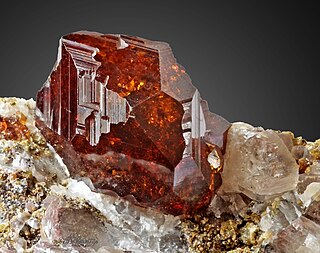
Garnets are a group of silicate minerals that have been used since the Bronze Age as gemstones and abrasives.
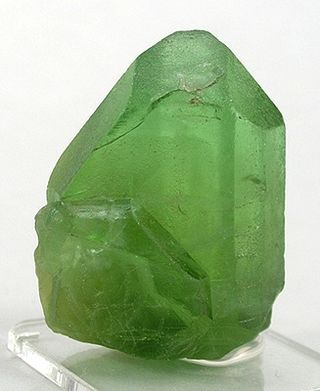
The mineral olivine is a magnesium iron silicate with the chemical formula (Mg,Fe)2SiO4. It is a type of nesosilicate or orthosilicate. The primary component of the Earth's upper mantle, it is a common mineral in Earth's subsurface, but weathers quickly on the surface. For this reason, olivine has been proposed as a good candidate for accelerated weathering to sequester carbon dioxide from the Earth's oceans and atmosphere, as part of climate change mitigation. Olivine also has many other historical uses, such as the gemstone peridot, as well as industrial applications like metalworking processes.
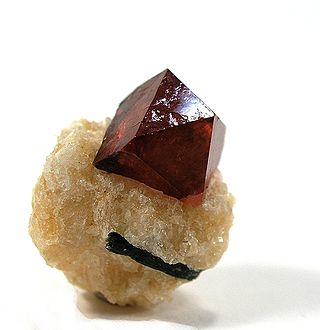
Zircon is a mineral belonging to the group of nesosilicates and is a source of the metal zirconium. Its chemical name is zirconium(IV) silicate, and its corresponding chemical formula is ZrSiO4. An empirical formula showing some of the range of substitution in zircon is (Zr1–y, REEy)(SiO4)1–x(OH)4x–y. Zircon precipitates from silicate melts and has relatively high concentrations of high field strength incompatible elements. For example, hafnium is almost always present in quantities ranging from 1 to 4%. The crystal structure of zircon is tetragonal crystal system. The natural color of zircon varies between colorless, yellow-golden, red, brown, blue, and green.
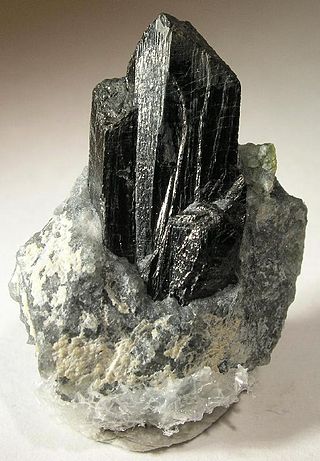
Baddeleyite is a rare zirconium oxide mineral (ZrO2 or zirconia), occurring in a variety of monoclinic prismatic crystal forms. It is transparent to translucent, has high indices of refraction, and ranges from colorless to yellow, green, and dark brown. See etymology below.
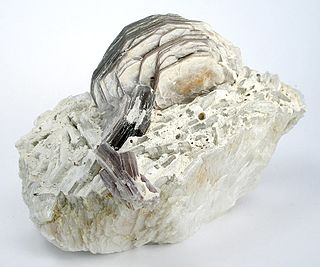
Lepidolite is a lilac-gray or rose-colored member of the mica group of minerals with chemical formula K(Li,Al)3(Al,Si,Rb)4O10(F,OH)2. It is the most abundant lithium-bearing mineral and is a secondary source of this metal. It is the major source of the alkali metal rubidium.

Uvarovite is a chromium-bearing garnet group species with the formula: Ca3Cr2(SiO4)3. It was discovered in 1832 by Germain Henri Hess who named it after Count Sergei Uvarov (1765–1855), a Russian statesman and amateur mineral collector. It is classified in the ugrandite group alongside the other calcium-bearing garnets andradite and grossular.

Almandine, also known as almandite, is a species of mineral belonging to the garnet group. The name is a corruption of alabandicus, which is the name applied by Pliny the Elder to a stone found or worked at Alabanda, a town in Caria in Asia Minor. Almandine is an iron alumina garnet, of deep red color, inclining to purple. It is frequently cut with a convex face, or en cabochon, and is then known as carbuncle. Viewed through the spectroscope in a strong light, it generally shows three characteristic absorption bands.
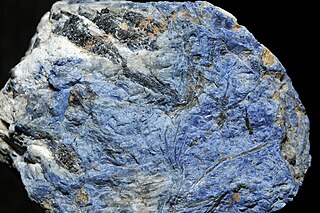
Dumortierite is a fibrous variably colored aluminium boro-silicate mineral, Al7BO3(SiO4)3O3. Dumortierite crystallizes in the orthorhombic system typically forming fibrous aggregates of slender prismatic crystals. The crystals are vitreous and vary in color from brown, blue, and green to more rare violet and pink. Substitution of iron and other tri-valent elements for aluminium result in the color variations. It has a Mohs hardness of 7 and a specific gravity of 3.3 to 3.4. Crystals show pleochroism from red to blue to violet. Dumortierite quartz is blue colored quartz containing abundant dumortierite inclusions.

Thorianite is a rare thorium oxide mineral, ThO2. It was originally described by Ananda Coomaraswamy in 1904 as uraninite, but recognized as a new species by Wyndham R. Dunstan. It was so named by Dunstan on account of its high percentage of thorium; it also contains the oxides of uranium, lanthanum, cerium, praseodymium and neodymium. Helium is present, and the mineral is slightly less radioactive than pitchblende, but is harder to shield due to its high energy gamma rays. It is common in the alluvial gem-gravels of Sri Lanka, where it occurs mostly as water worn, small, heavy, black, cubic crystals. The largest crystals are usually near 1.5 cm. Larger crystals, up to 6 cm (2.4 in), have been reported from Madagascar.
Anandite is a rare phyllosilicate with formula (Ba,K)(Fe2+,Mg)3(Si,Al,Fe)4O10(S,OH)2. It crystallizes in the monoclinic crystal system. It is black in color with a glassy luster and a near perfect cleavage.

Tobermorite is a calcium silicate hydrate mineral with chemical formula: Ca5Si6O16(OH)2·4H2O or Ca5Si6(O,OH)18·5H2O.

Perhamite is a phosphate mineral with the formula Ca3Al7(SiO4)3(PO4)4(OH)3·16.5(H2O). It occurs in rare isolated masses in amblygonite-rich pegmatite deposits throughout the world. It was discovered in platy sheed form of 1mm hexagonal crystals. It was first described in 1977 by P.J. Dunn and D.E. Appleman from pegmatite collected from Bell Pit, Newry, Maine. Other specimens have been found in Kapunda, South Australia, in Silver Coin mine near Humboldt County, Nevada and various locations throughout Europe.

Bultfonteinite, originally dutoitspanite, is a pink to colorless mineral with chemical formula Ca2SiO2(OH,F)4. It was discovered in 1903 or 1904 in the Bultfontein mine in South Africa, for which the mineral is named, and described in 1932.

Collinsite is a mineral with chemical formula Ca
2(Mg,Fe2+
)(PO
4)
2•2H
2O. It was discovered in British Columbia, Canada, and formally described in 1927. It was named in honor of William Henry Collins (1878–1937), director of the Geological Survey of Canada. There are three varieties of the mineral: magnesian collinsite, zincian collinsite, and strontian collinsite. The crystal structure consists of polyhedral chains linked by weak hydrogen bonds.

Gyrolite, NaCa16(Si23Al)O60(OH)8·14H2O, is a rare silicate mineral (basic sodium calcium silicate hydrate: N-C-S-H, in cement chemist notation) belonging to the class of phyllosilicates. Gyrolite is also often associated with zeolites. It is most commonly found as spherical or radial formations in hydrothermally altered basalt and basaltic tuffs. These formations can be glassy, dull or fibrous in appearance.

Zirsilite-(Ce) is a very rare mineral of the eudialyte group, with formula (Na,□)12(Ce,Na)3Ca6Mn3Zr3NbSi(Si9O27)2(Si3O9)2O(OH)3(CO3)·H2O. The original formula was extended to show the presence of cyclic silicate groups and the presence of silicon at the M4 site, according to the nomenclature of the eudialyte group. Zirsilite-(Ce) differs from carbokentbrooksite in cerium-dominance over sodium only. Both minerals are intimately associated. The only other currently known representative of the eudialyte group having rare earth elements (in particular cerium, as suggested by the "-Ce)" Levinson suffix in the name) in dominance is johnsenite-(Ce).
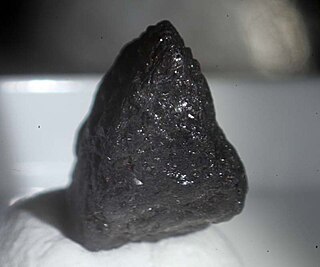
Lucchesiite is a new member of tourmaline-group of minerals. Lucchesiite has the formula CaFe3Al6(Si6O18)(BO3)3(OH)3O. It is the calcium and oxygen-analogue of schorl. It has two co-type localizations, one in Czech Republic and the other in Sri Lanka. As the other members of the tourmaline group, it is trigonal.
Eheliyagoda is a town in Ratnapura District, Sabaragamuwa Province, Sri Lanka. It is located approximately 72 km (45 mi) east of Colombo.


















